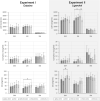Ostarine and Ligandrol Improve Muscle Tissue in an Ovariectomized Rat Model
- PMID: 33042018
- PMCID: PMC7528560
- DOI: 10.3389/fendo.2020.556581
Ostarine and Ligandrol Improve Muscle Tissue in an Ovariectomized Rat Model
Abstract
In postmenopausal women, hormonal decline changes muscle function and structure. The non-steroidal selective androgen receptor modulators (SARMs) Ostarine (OS) and Ligandrol (LG) have been shown to increase muscle mass and physical function while showing a relative low risk profile. Information about their effects on muscle structure and metabolism is lacking. To analyze this, two experiments were performed using ovariectomized rats as a standard model for postmenopausal conditions. In each experiment, 3-month old Sprague-Dawley rats were divided into five groups (n = 12 to 15). One group remained intact (Non-OVX), the other four groups were ovariectomized (OVX) and remained untreated for eight (OS Experiment) or nine (LG Experiment) weeks. Thereafter, rats of three of the four OVX groups were treated with OS or LG (with doses of 0.04, 0.4, or 4 mg/kg body weight/day) for 5 weeks. Then, uterus, gastrocnemius, and soleus muscles were weighed, fiber size, capillary density, and enzyme activity (lactate dehydrogenase [LDH], citrate synthase [CS], and complex I) were analyzed. In the LG experiment, intramuscular fat content was determined in the quadriceps femoris muscle. All OS treatments resulted in a higher capillary density in the gastrocnemius and longissimus muscles compared with the Non-OVX and the OVX rats, whereas all LG treatments showed a higher capillary density compared with the Non-OVX group. Muscle fiber size and distribution patterns were not changed under either SARM. The CS activity was higher in the longissimus muscle under OS treatment. LG resulted in a higher activity of CS in the gastrocnemius and of LDH in the longissimus muscle. Both SARMs showed an uterotrophic effect, OS at 4 and 0,4 mg dosages, LG at 4 mg dosage. In sum, beneficial effect on muscle vascularization was observed for both SARMs with a stronger impact for OS. LG showed more effect on muscle metabolism. However, a higher muscle weight and intramuscular fat content observed after LG treatment (4 mg) as well as an uterotrophic effect of both SARMs at higher dosages could be considered as an unfavorable side effects and might be a limitation for their application at these dosages.
Keywords: ligandrol; muscle correspondence; ostarine; ovariectomized rats; postmenopausal osteoporosis; selective androgen receptor modulators (SARMs).
Copyright © 2020 Roch, Henkies, Carstens, Krischek, Lehmann, Komrakova and Sehmisch.
Figures




Similar articles
-
Advantage of ostarine over raloxifene and their combined treatments for muscle of estrogen-deficient rats.J Endocrinol Invest. 2024 Mar;47(3):709-720. doi: 10.1007/s40618-023-02188-z. Epub 2023 Sep 6. J Endocrinol Invest. 2024. PMID: 37672168 Free PMC article.
-
Effects of ligandrol as a selective androgen receptor modulator in a rat model for osteoporosis.J Bone Miner Metab. 2023 Nov;41(6):741-751. doi: 10.1007/s00774-023-01453-8. Epub 2023 Jul 6. J Bone Miner Metab. 2023. PMID: 37407738
-
The Selective Androgen Receptor Modulator Ostarine Improves Bone Healing in Ovariectomized Rats.Calcif Tissue Int. 2020 Feb;106(2):147-157. doi: 10.1007/s00223-019-00613-1. Epub 2019 Sep 17. Calcif Tissue Int. 2020. PMID: 31531719
-
Evaluation of ostarine as a selective androgen receptor modulator in a rat model of postmenopausal osteoporosis.J Bone Miner Metab. 2019 Mar;37(2):243-255. doi: 10.1007/s00774-018-0929-9. Epub 2018 May 21. J Bone Miner Metab. 2019. PMID: 29785666
-
Selective androgen receptor modulators (SARMs) as pharmacological treatment for muscle wasting in ongoing clinical trials.Expert Opin Investig Drugs. 2020 Aug;29(8):881-891. doi: 10.1080/13543784.2020.1777275. Epub 2020 Jun 18. Expert Opin Investig Drugs. 2020. PMID: 32476495 Review.
Cited by
-
Advantage of ostarine over raloxifene and their combined treatments for muscle of estrogen-deficient rats.J Endocrinol Invest. 2024 Mar;47(3):709-720. doi: 10.1007/s40618-023-02188-z. Epub 2023 Sep 6. J Endocrinol Invest. 2024. PMID: 37672168 Free PMC article.
-
Ostarine blunts the effect of endurance training on submaximal endurance in rats.Naunyn Schmiedebergs Arch Pharmacol. 2024 Sep;397(9):6523-6532. doi: 10.1007/s00210-024-03030-w. Epub 2024 Mar 7. Naunyn Schmiedebergs Arch Pharmacol. 2024. PMID: 38451281 Free PMC article.
-
An integrated study of hormone-related sarcopenia for modeling and comparative transcriptome in rats.Front Endocrinol (Lausanne). 2023 Feb 1;14:1073587. doi: 10.3389/fendo.2023.1073587. eCollection 2023. Front Endocrinol (Lausanne). 2023. PMID: 36817606 Free PMC article.
-
Treatment of osteoporosis using a selective androgen receptor modulator ostarine in an orchiectomized rat model.Endocrine. 2023 Sep;81(3):579-591. doi: 10.1007/s12020-023-03422-7. Epub 2023 Jun 28. Endocrine. 2023. PMID: 37378829 Free PMC article.
-
Effects of ligandrol as a selective androgen receptor modulator in a rat model for osteoporosis.J Bone Miner Metab. 2023 Nov;41(6):741-751. doi: 10.1007/s00774-023-01453-8. Epub 2023 Jul 6. J Bone Miner Metab. 2023. PMID: 37407738
References
-
- Briggs AM, Cross MJ, Hoy DG, Sanchez-Riera L, Blyth FM, Woolf AD, et al. . Musculoskeletal health conditions represent a global threat to healthy aging: a report for the 2015 World health organization world report on ageing and health. Gerontologist. (2016) 56(Suppl. 2):S243–55. 10.1093/geront/gnw002 - DOI - PubMed
-
- Hernlund E, Svedbom A, Ivergard M, Compston J, Cooper C, Stenmark J, et al. Osteoporosis in the European Union: medical management, epidemiology and economic burden. A report prepared in collaboration with the International osteoporosis foundation (IOF) and the European federation of pharmaceutical industry associations (EFPIA). Arch Osteoporos. (2013) 8:136 10.1007/s11657-013-0136-1 - DOI - PMC - PubMed
Publication types
MeSH terms
Substances
LinkOut - more resources
Full Text Sources

